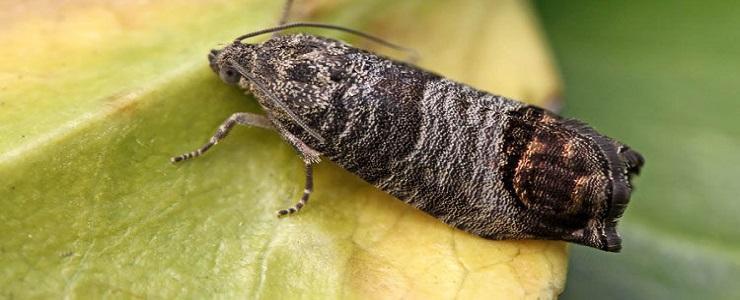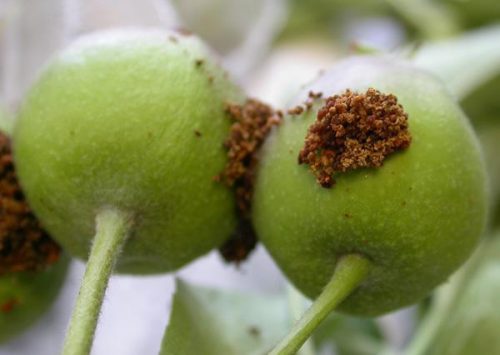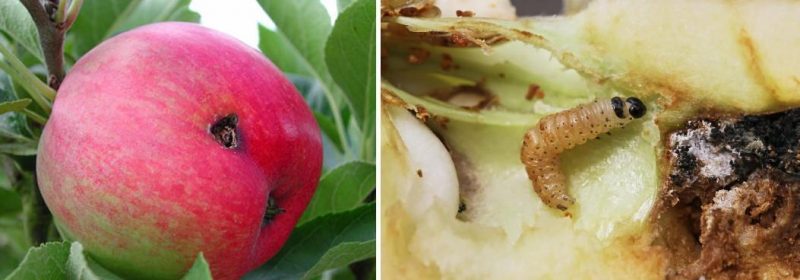The Codling moth (Cydia pomonella) – pest management

The codling moth, Cydia pomonella, is widespread on all continents in all fruit-growing areas, especially in untended apple orchards. It is one of the most dangerous pests of the apple tree, having a very good ability to adapt to environmental conditions.
The pests’ harmful behavior requires constant monitoring and control.
Description. The adult is a small butterfly, with a wingspan of 15-22 mm and a body length of 10 mm. The body is brownish-gray. The forewings are brown-gray, with dark-gray transverse stripes. At the tip of the forewings, it has a brown crescent-shaped spot with a metallic gloss, bordered by a reddish edge. The hind wings are reddish-brown with a coppery gloss. The apical edges of the wings are fringed.
The egg has the shape of a shield, at first, it is hyaline (the same color as the egg white) and during the incubation period, it goes through several phases. The larva is a light pink caterpillar, with a brown head and when fully developed it is 15-20 mm long. On its back, each segment has 2 dark warts, provided with sensitive hairs. The pupa is yellow-brown or dark brown and it has a length of 9-10 mm.
Biology and ecology
The codling moth produces 2 generations a year and overwinters in the fully developed larval stage, in a silk cocoon, under the bark of the trunk, in its cracks, or in the places of fruit storage.
In spring, when temperatures exceed 9° C, the larvae turn into pupae. Adults become active at temperatures exceeding 15° C, starting in May, until June, and fly during the twilight or at night. Immediately after the appearance of the adults, copulation takes place and the females lay eggs in groups of 2-3 eggs, on leaves, fruits, and shoots. A female lays an average of 50-60 eggs but can lay up to 150. After 8-15 days of incubation, the larvae hatch and penetrate the fruit either through the side or through the peduncle or calyx. Here, the larvae feed for 20-30 days until full development and then migrate to the stem, under its bark, or in the soil to build a silky cocoon in which it turns into a pupa. Adults appear after 10-14 days (late June-early July) and give birth to the second generation.
The second generation develops from the second half of July until September. Eggs of this generation are laid directly on the fruit, less often on the leaves. The larvae penetrate the fruit on the side and cover the hole with a leaf or with another fruit. When fully developed, the larvae emerge from the fruit and migrate to overwintering shelters, where they remain in diapause until the following spring.
The codling moth life cycle
It is conditioned by several climatic factors. Low temperatures during the dormancy period cause the death of 60-70% of overwintering larvae. Temperatures below 12° C and above 27° C limit the mating of the first generation adults. Heavy rainfall and strong winds prevent the moths from flying, mating, and laying eggs.
The biotic factors that affect the development and multiplication of the pest are represented by its natural predators and parasites.
Attacked plants and damages
The codling moth mainly attacks the apple and the pear trees, but sometimes it also attacks the quince, the walnut, and the plum trees.
The attack of the larvae may be in the form of superficial bites or in the form of galleries with droppings and browned bits around the perforation hole.
The larvae from the first generation cause large losses to the affected fruits because, being small, they fall and can no longer be recovered. The larvae from the second generation attack the fruits close to maturity, forcing them to ripen earlier. Some of them fall, some rot or remain attached to the tree, but have a low commercial value. The attacked fruits, even if they have reached maturity, cannot be preserved because the holes formed by the larvae allow the penetration of microorganisms that cause rotting (the Monilinia fructigena fungus that causes the appearance of brown rot of stone fruit).
Damages can sum up to 70-80% of the entire production.
Control
In orchards and gardens, it is necessary to apply measures to limit the population of Cydia pomonella. Thus, the infested fruits have to be gathered after they fall on the ground and be used for another purpose or destroyed. Embossed cardboard belt-traps should be applied to the tree trunks, in order to attract the larvae. These have to be removed and destroyed before the vegetative period begins.
Biological control
It can be achieved by applying treatments with bacterial insecticides (thuringin, based on Bacillus thurigiensis). Pheromone traps can also be used to disorient and capture males.
Recommended products
-
You can find products on a different store
Change Store -
You can find products on a different store
Change Store -
You can find products on a different store
Change Store -
You can find products on a different store
Change Store -
You can find products on a different store
Change Store -
You can find products on a different store
Change Store -
You can find products on a different store
Change Store -
You can find products on a different store
Change Store -
You can find products on a different store
Change Store -
You can find products on a different store
Change Store -
You can find products on a different store
Change Store -
You can find products on a different store
Change Store -
You can find products on a different store
Change Store -
You can find products on a different store
Change Store -
You can find products on a different store
Change Store -
You can find products on a different store
Change Store -
You can find products on a different store
Change Store -
You can find products on a different store
Change Store -
You can find products on a different store
Change Store -
You can find products on a different store
Change Store -
You can find products on a different store
Change Store -
You can find products on a different store
Change Store -
You can find products on a different store
Change Store -
You can find products on a different store
Change Store
For the first generation, the treatments have to be applied when capturing 3-4 males/ha/week and for the second generation, when 2-3 males/ha/week are captured.
The treatments have to be applied every 7 days, in the following phenophases: when the petals fall, when the fruit is big like a hazelnut when the fruit is big as a walnut, and against the second generation when the fruits exceed 3.5 cm in diameter.
The treatments have to be carried out with specific insecticides.
Recommended products
-
You can find products on a different store
Change Store -
You can find products on a different store
Change Store -
You can find products on a different store
Change Store -
You can find products on a different store
Change Store -
You can find products on a different store
Change Store -
You can find products on a different store
Change Store -
You can find products on a different store
Change Store -
You can find products on a different store
Change Store -
You can find products on a different store
Change Store -
You can find products on a different store
Change Store -
You can find products on a different store
Change Store -
You can find products on a different store
Change Store -
You can find products on a different store
Change Store -
You can find products on a different store
Change Store -
You can find products on a different store
Change Store -
You can find products on a different store
Change Store -
You can find products on a different store
Change Store -
You can find products on a different store
Change Store -
You can find products on a different store
Change Store -
You can find products on a different store
Change Store -
You can find products on a different store
Change Store -
You can find products on a different store
Change Store -
You can find products on a different store
Change Store -
You can find products on a different store
Change Store


















































































































































































































































































































































































































































